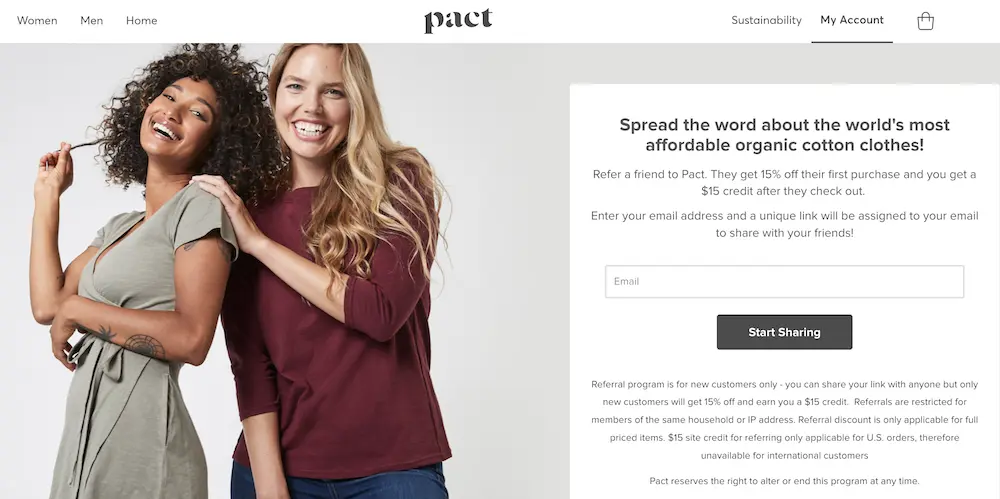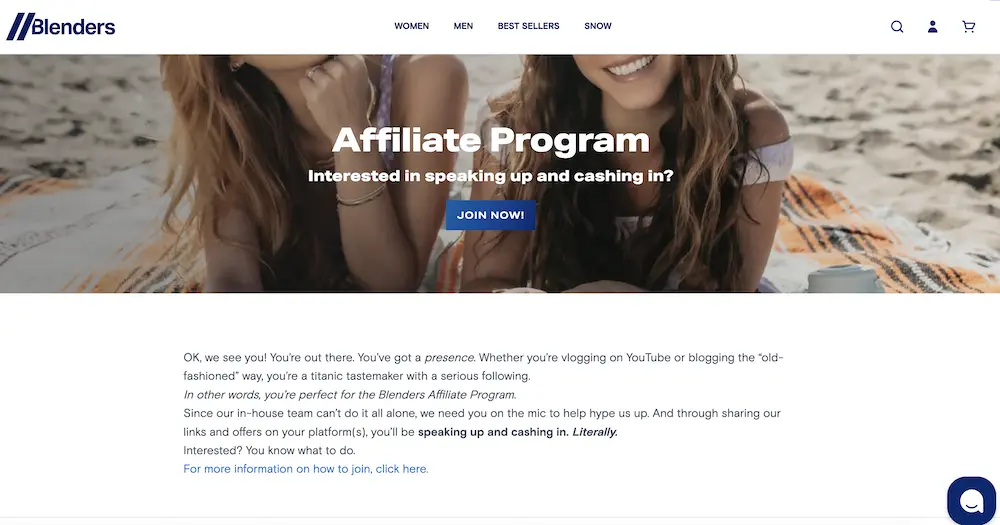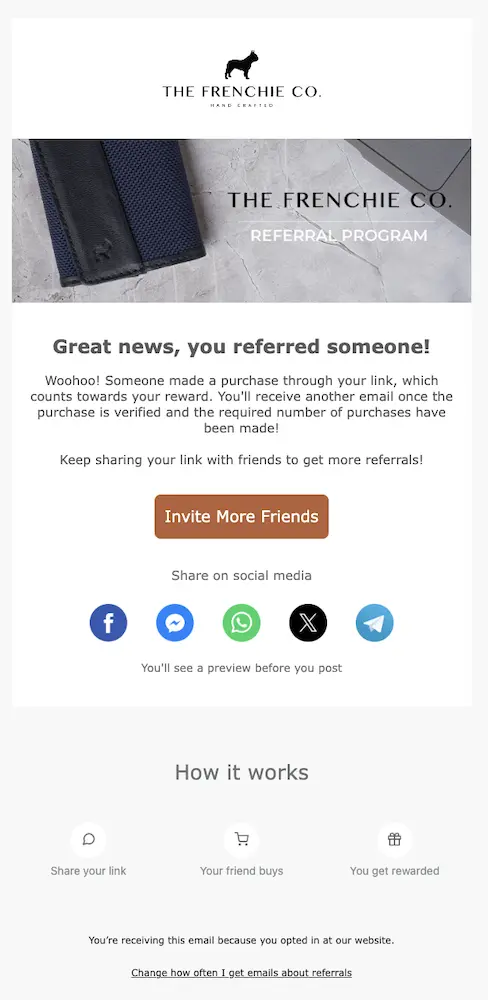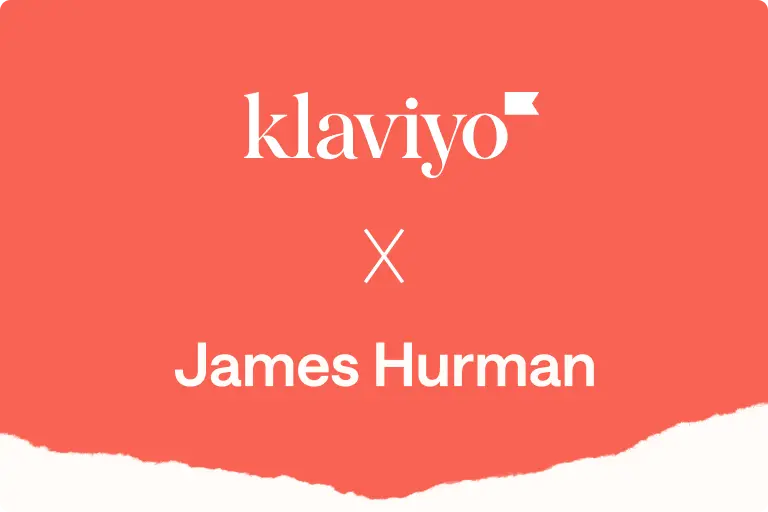
How to create a referral program in 10 steps

Word of mouth has always been a powerful force in marketing, and for ecommerce brands, it can be a game-changer.
Picture this: a satisfied customer loves your product so much, they tell their friends and family. Soon, your brand is buzzing in group chats, on social media, and beyond.
This is the power of referrals. According to Nielsen’s 2021 Trust in Advertising Study, 88% of consumers trust recommendations from people they know over any other form of advertising.
A referral program involves encouraging customers to recommend your products or services to their friends and family, typically by offering incentives for successful referrals. And a well-crafted referral program doesn’t only build brand awareness—it creates a ripple effect that can boost sales and foster long-term customer loyalty.
Here, we walk you through how to create a referral program that turns satisfied shoppers into your most influential marketers.
1. Set clear referral program goals and track relevant metrics
Your referral program’s success hinges on having clear, actionable goals. They define what you’re trying to achieve, while the metrics yout tie to these goals help you track how successful your referral program is.
Here are 4 common referral program goals and the metrics to keep an eye on to make sure you’re on the right track:
If your goal for your referral program is to grow your customer base, track your referral rate. This metric tells you the percentage of your existing customers who refer others to your brand. A high referral rate shows that your customers are actively promoting your business and helping you reach new audiences.
If you want to make sure referrals are driving actual revenue, focus on your conversion rate. This metric measures how many referred customers go on to make a purchase. A high conversion rate indicates that your referral program isn’t only generating interest but also turning referrals into paying customers.
If you’re aiming to turn one-time buyers into loyal customers, pay attention to metrics like retention rate and customer lifetime value (CLV). Retention rate tells you how often referred customers return to buy again, while CLV measures how much a customer is likely to spend with your brand over time. Both give you insight into how effective your referral program is at fostering long-term relationships.
To make sure you’re not spending a fortune bringing in new customers, track your customer acquisition cost (CAC). A low CAC indicates that your referral program is helping you attract new customers at a lower cost compared to other marketing channels.
2. Identify potential referral sources and channels
Where are your best customers most likely to hear about and talk about your brand? Is it on social media, through personal recommendations, or in online reviews?
Knowing where your customers are talking about your brand helps you focus your referral efforts where they’ll make the most impact.
Here are a few steps you can take to identify potential referral sources:
- Check your website analytics to learn where your traffic originates.
- Analyze customer reviews for specific mentions of how customers discovered your brand.
- Keep tabs on social media interactions to identify where conversations about your brand are buzzing.
- Send post-purchase surveys to your customers to ask directly how they discovered your brand and product.
Electronics and lifestyle brand Nomad, for example, discovered through post-purchase surveys that 12% of their new customers heard about them from friends and family. To capitalize on this, they plan to roll out a referral program that encourages word-of-mouth recommendations. By collecting direct feedback from customers through surveys and sign-up forms, Nomad refined their approach and reached more potential buyers—all without relying on third-party data.
“Collecting self-reported data from the customer on where they’re learning about our brand vs. relying on data from Google, Facebook, or other third-party analytics is essential for us now,” says Chuck Melber, marketing director at Nomad.
“The data has been really illuminating,” Melber adds. “It surfaced channels we didn’t realize we were gaining new customers from and helped to validate our past hypotheses. Best of all, it’s giving us the opportunity to double down on those new areas of success.”
3. Choose the right referral approach
Before determining how you’ll incentivize customers to refer your business, think about the type of referrals you want to encourage. Every brand is different, and the way your customers spread the word should align with your goals and brand values.
Here are a few ideas to consider:
Friend-to-friend referrals
This is the classic approach where satisfied customers invite their friends and family to check out your brand. It’s personal and trusted, like when someone says, “You have to try this.”
In their referral program, eco-friendly clothing brand Pact keeps it simple: if a customer refers a friend, both get a discount.

Influencer referrals
If you’re especially active on social media, consider collaborating with influencers to spread the word about your brand.
One brand that knows how to take advantage of influencer referrals is Kulani Kinis. The Australian swimwear company’s Sun Chasers program has over 22,000 ambassadors who share posts on Instagram and TikTok.
To manage this huge network, Kulani Kinis uses Klaviyo’s Gatsby integration. Gatsby enhances the customer data stored in Klaviyo with social media metrics, such as follower counts and post mentions, making it possible for the Kulani Kinis team to automatically reward their best brand advocates with incentives like personalized vouchers and discount codes.
“The benefit of this is twofold,” explains Kirsten Laurendet, who manages knowledge, consulting & digital marketing at Kulani Kinis: “We create a community at scale for customers and influencers who want to grow their following and engage with our brand, beyond just purchasing our products, and in return we receive rich UGC to reshare on socials and develop invaluable advocates for our brand.”
And it works: Kulani Kinis generated $425,000 in revenue from their Sun Chasers program in just 6 months.
Affiliate programs
The affiliate approach is similar to the influencer approach, but a bit more structured. You team up with affiliates, like bloggers or websites, who recommend your products to their audience in exchange for a commission on each sale they drive to your brand.
A great real-world example of an affiliate referral program comes from Blenders Eyewear. The brand’s Street Team ambassador program turns loyal customers into affiliates who promote the brand in exchange for rewards and perks.

Blenders relies on Klaviyo’s Refersion integration to automate scalable parts of the program, like creating tiered offerings for affiliates, tracking affiliate conversions, paying out affiliates for conversions, and keeping them engaged with brand news and community updates.
The strategy paid off, contributing to a 270% increase in affiliate revenue in a single year.
4. Determine your referral program incentives
It’s important to find the appropriate incentive to keep your customers engaged in making referrals. There are various types of incentives you can offer, such as:
Whether they’re dollar-amount or percentage-off discounts or a set amount of store credit, this model works particularly well for friend-to-friend referrals, where both the referrer and the new customer receive a discount or credit on future purchases. It’s simple, easy to understand, and gives customers a great reason to share with their friends.
Offering free products or early access to new releases can create excitement and motivate referrals. These incentives typically appeal to VIP customers who appreciate exclusivity, or to influencers who can use the products and offers to help generate buzz around your brand.
In many scenarios, particularly in affiliate referral programs, financial incentives such as a percentage of sales are standard. This approach appeals to affiliates like bloggers or content creators, who often prefer performance-based rewards.
5. Segment your audience with referrals in mind
When you’re ready to start collecting referrals, the first step is to identify which customers are most likely to spread the word about your brand. If someone hasn’t opened an email or text from you in the last 60 days, for example, they’re probably not going to refer your brand to a friend.
Instead of blasting your entire email or SMS list asking for a referral, share news about your referral program selectively with customers you know are loyal and invested in your brand. When asking for referrals, segment your customers based on those who are most likely to refer your business. That might include:
- Repeat customers
- Customers who are subscribed to both email and SMS
- Email and SMS subscribers who engage frequently with your marketing messages
- Loyalty program members
- Recent buyers
- VIP customers who either purchase frequently or have a high CLV
6. Encourage your happy customers to refer your business
Remember, collecting referrals from your happiest customers won’t just be a one-time thing. It’s important to implement an ongoing strategy that targets the right people at the right moment and keeps the momentum going long-term.
A great place to start is your owned marketing channels: email and SMS. When developing your referral communications strategy, think about the moments when your happiest customer segments might feel most excited to refer your business, and use a combination of planning, segmentation, and marketing automation to reach them at those moments. For example:
- After a customer makes their third purchase
- After a customer exceeds a certain CLV threshold
- After a customer leaves a 5-star review
- After a customer joins your loyalty program
Here, see how ILIA Beauty targets their loyal customers with a referral email campaign that offers subscribers a discount for referring a friend:

But referral communications are also something you can automate. Here, Ritual, a subscription-based supplement company, incorporates information about their referral program into a transactional email that gets triggered when a customer places a new order:

Of course, getting the word out about your referral program will probably involve more than just email and SMS. Stationery Pal shares details about their referral program on their blog; The Folklore, a global independent brand membership community, launched theirs on Instagram.
The goal is to use an omnichannel marketing approach to not only make your best customers aware of your referral opportunities, but also nurture more and more of them to continue spreading the word about your brand on an ongoing, not just one-time, basis.
7. Thank your existing customers for referring your brand
Okay, so a customer has just referred a friend to your brand. What now?
Time to show your gratitude with a message that not only thanks the referrer, but also shares the incentive you promised them.
Here, accessories and lifestyle brand The Frenchie Co. follows up with referrers to let them know someone made a purchase through their referral, and to encourage them to keep spreading the word to make more progress toward their reward:

8. Welcome your new customers to the fold
After the referred friend accepts the referrer’s invite, it’s time to express your gratitude. Send a warm welcome message that includes helpful information about your brand and offerings, making the new customer feel valued from the start.
Make sure your welcome email includes the incentive you promised for the new customer’s first purchase as part of the referral program engine.
Watch how cookware brand Our Place adds a personal touch to their referral program welcome email. When subscribers tell a friend about the brand, they get $20 off their next purchase—and their recommendation note to that friend acts as social proof in the welcome email the friend receives from the brand.

9. Track and optimize your referral program
Once everything is in place, track metrics tied to the initial referral program goals you set to monitor performance and understand whether you need to make adjustments to your program. Depending on the goals you set, metrics to track might include:
- Referral rate
- Conversion rate
- Retention rate
- Customer lifetime value (CLV)
- Customer acquisition cost (CAC)
Keeping an eye on these will help you gauge how well your referral program is working—and find creative ways to improve what’s not so that your referral program continues helping you achieve your goals.
10. Manage your referral program with Klaviyo integrations
This process can get fairly complicated without the right tech stack.
But with a marketing platform like Klaviyo that’s integrated with a platform like ReferralCandy or Friendbuy, you can:
- Create unique referral links for each customer.
- Track exactly who’s referring new customers and who’s getting referred.
- Sync referral data with your owned marketing channels.
- Keep your customer profiles up to date in real time.
These platforms automate the reward process, sending out discounts or store credits when a referral is successful. By using them in combination with Klaviyo, you can add referral links to your email and SMS campaigns, remind customers to redeem their rewards, and manage all your referral data under one roof.
Related content
- More than just a confirmation: 9 post-purchase email ideas that drive engagement, revenue, and loyalty
- Customer loyalty program tips that make an impact on growth
- 15 customer marketing retention strategies by real brands

Related content

Discover how leading brands use Klaviyo to grow subscription businesses. Learn strategies for upselling, personalization, retention flows, and advanced automations that increase lifetime value and reduce churn.

New research shows brands that retain fewer customers—but increase those customers’ spend—are growing at more than 3x the rate of brands that retained more but failed to increase spend.

With potential tariffs creating uncertainty and threatening profit margins, here are 3 ways marketers can use Klaviyo to stay resilient and protect profits in any economy.